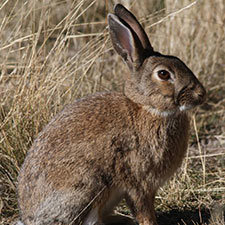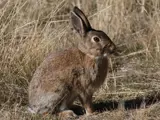 Wild rabbits
Wild rabbits
Common name: Wild rabbit
Botanical name: Oryctolagus cuniculus
Management programme: Advisory
Where are they originally from?
- Initially released by Captain Cook onto an island in Queen Charlotte Sound in 1777. In the 1850, wild rabbits were released.
- Often brought on ships for food and fur and were released to establish populations for food and fur.
Why are they a pest?
- Largely an agricultural pest, they compete with livestock for pasture. 7-10 rabbits consume as much as one ewe.
- Stable food source for mammalian carriers of bovine Tb.
- Populations can build quickly in optimal conditions, females can adjust litter-sizes based in food availability.
- Burrowing and scrapes cause extensive damage, especially on erosion prone soils.
- Browse on vulnerable native plant communities and in restoration plantings.
Where are they found?
Wild rabbits are found throughout most of New Zealand in varying densities, with the highest densities in Central Otago, McKenzie Basin, North Canterbury and Malborough. They prefer open areas with short vegetation and suitable soil to be able to burrow. They avoid cold and wet habitats.
What do they look like?
- Small herbivores that are brown to grey-brown in colour.
- They have long ears and large hind feet.
- A distinctive hopping gait when foraging and will run rapidly if they feel threatened.
What are the rules?
Advisory
Council does not enforce the control of advisory species. It is landowner/occupier responsibility to manage these pests. Council may provide advice on how to manage or control advisory species if required.
How do you get rid of them?
- Shooting
- Fumigation
- Poisoning
CAUTION: When using pesticide please READ THE LABEL thoroughly to ensure that all instructions and safety requirements are followed. All firearms laws MUST be adhered to when using a firearm. When using traps please ensure that all instructions, safety requirements and laws (in particular the Animal Welfare Act 1999) are followed.
NAWAC (National Animal Welfare Advisory Committee) approved kill traps need to be set as per the manufacturers guidelines.
Guidelines on trap use https://www.mpi.govt.nz/animals/animal-welfare/animal-welfare-and-pest-management/traps-and-devices/
DISCLAIMER: Information in this fact sheet regarding pesticides does not necessarily appear on the labels of the products concerned. Bay of Plenty Regional Council does not accept liability for any damage that may arise from the use of pesticides at non-standard rates. Mention of product trade names implies neither endorsement of those products nor criticism of similar products not mentioned. Bay of Plenty Regional Council does not accept liability for any damage or injury that may arise from the use of traps, toxins and firearms.
Read more on pest control guidelines and regulations
Images

